Selective RCD: device, purpose, scope of application + diagram and connection nuances
Among the variety of protective devices, there is a selective RCD, which experts note as a practical and optimal option for organizing protection. How does this type of device stand out from others in a related group?
What properties does a selective device have and how high is its sensitivity? Let's try to figure it out with a short review in this direction.
The content of the article:
Purpose and principle of operation
Relay devices for electrical networks, designed to provide protection from direct contact in hazardous areas, as well as equipment protection, are represented by a variety of design.
Features of selective devices
A distinctive feature of a selective device is the presence in the circuit of a time delay function for turning off the circuit that powers the load.
Typically, this parameter exceeds 40 ms - this means that selective devices are not designed to protect against damage from direct contact.
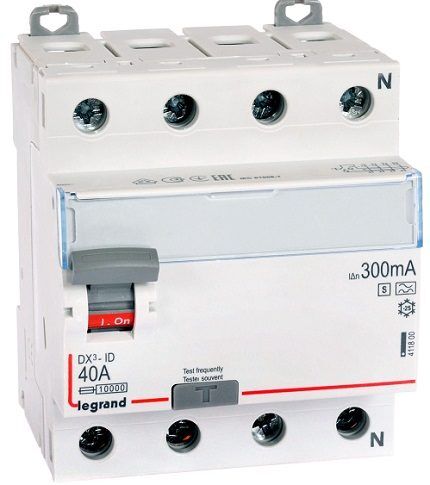
Also among the features of selective devices, it should be noted their good stability in response to current and voltage surges. Thanks to this property, the risk of false alarms and, accordingly, circuit shutdowns is almost completely eliminated.What selectivity of circuit breakers is is described in detail in this material.
As a rule, in practice, devices are used whose rated current is in the range of 25-100 A. In this case, the value of the differential leakage current is in the range of 0.1-0.3 A.
Two-pole and four-pole versions of the device are manufactured. Each type is actively used as part of branched cascade circuits.
Operating principle and design of RCD type S
The distinctive features of selective devices are limited only to those indicated above.
In all remaining design functionality, there is virtually no significant difference between selective devices and general-purpose devices.
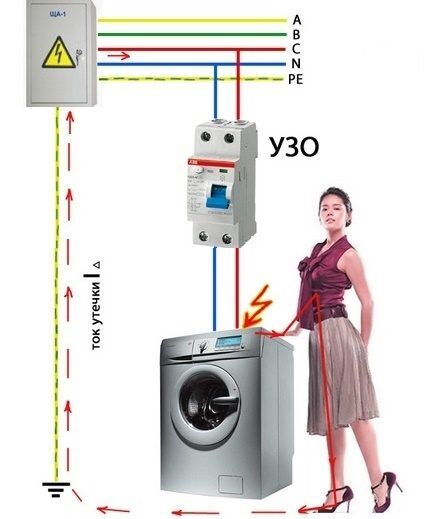
The principle of operation, accordingly, remains standard - applicable to all protective devices from the RCD group:
- There is a differential transformer in the design.
- Thanks to the transformer, a comparison of the control currents is carried out.
- The difference is transmitted to the sensing element.
- If the difference exceeds the set control parameter, a cutoff occurs.
That's the whole operating principle in general terms. However, it is also worth noting such a feature as the dependence of the devices on power supply.
In practice, two design options for selective-type RCDs (and general ones too) are used. One of the options involves external power supply, while the other excludes it completely.
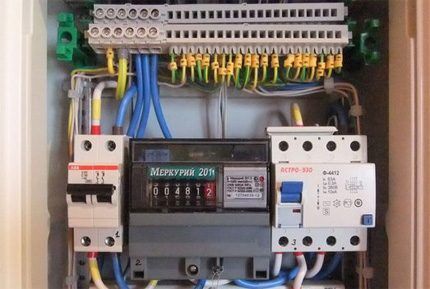
It is clear that protective device designs that do not use an external power circuit appear to be more reliable than those that require an energy source for operational efficiency.
Since the differential transformer is, in fact, the dominant design element, special requirements are imposed on this part of the RCD circuit.
The magnetic core of the DT must have a strict linear magnetization characteristic.
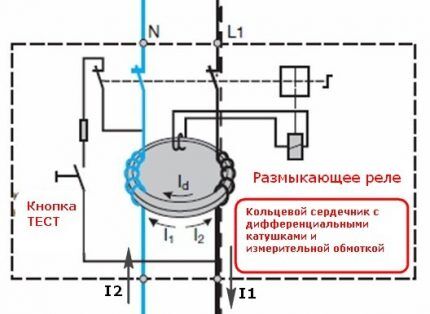
The temperature properties of the magnetic core should ensure high-quality operation over a wide temperature range. Therefore, to manufacture this element, a special material is used - amorphous iron or the like.
Other parts of the design of a selective RCD device are sensitive magnetoelectric relays - direct-acting elements, often called threshold elements.
In some designs, relays are replaced by electronics, but the principle remains the same.
Normal and emergency modes
When operating an S-type RCD, until the presence of a leakage current (differential current) is detected, the conductors forming an electrical circuit in the magnetic field of the core pass equivalent rated load currents.

These currents, equal in magnitude, induce magnetic fields of multidirectional action inside the core.
Their total flux turns out to be zero, which explains the absence of current on the secondary winding of the diesel generator. Its zero current has no effect on the cutoff sensing element. The RCD remains on.
Otherwise, when the described circuit is disturbed, the balance of currents is also disturbed. As a result, a current of a certain magnitude is generated on the secondary winding of the DT.
As soon as this value exceeds the threshold value of the trigger element of the selective protective device, it will operate. Which will activate the executive blocking system - cutting off the load power circuits. The RCD will turn off and cut off the load circuit.
Traditional areas of application of the device
As noted above, this modification of protective devices is not used for protection against direct contact.
Most often, the devices are used as interlocks in case of a possible fire in electrical wiring or system mechanisms.
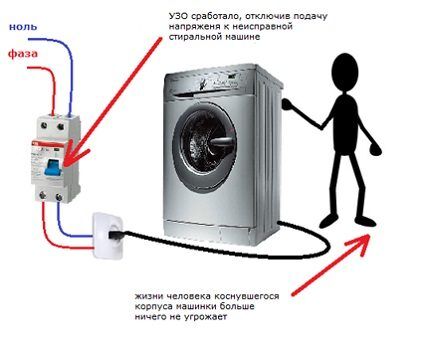
These same RCDs are used as protective equipment against short circuits in the power supply circuits of valuable expensive installations/devices/equipment or in the supply circuits of important technological systems.
It is common practice to introduce selective devices when constructing complex cascade electrical circuits, where each branch involves a different type of load with different currents.

With this configuration of the electricity branching system using selective devices, reliable protection is provided in individual areas.
And also, each individual RCD in the event of an accident provides the ability to quickly determine the defect.
Connection diagrams for selective cut-off RCDs
Actually, the circuit solutions in this case theoretically do not have any features that would distinguish them from the construction of circuits with other types of devices in the group.
Another question is, in what sequence should we include, say, selective cutoff and direct touch cutoff?
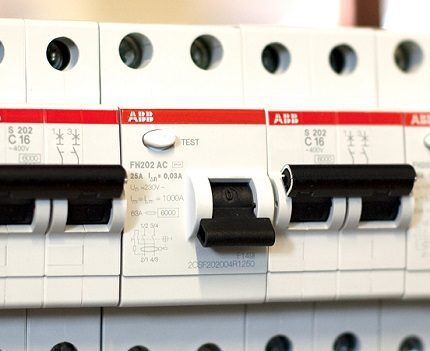
If we consider the selective shutdown device in a single version, then in this case it is an element of the simplest circuit and is mounted as standard:
- The circuit breaker is installed first.
- Next comes the RCD type S.
- Then the load chain.
Meanwhile, protection is used in a variety of ways to use electrical networks.
For example, it is necessary to ensure high reliability of the operation of a three-phase electric motor. How to organize protection through a selective type RCD in this case?

A four-pole device is suitable here, with the help of which you can organize a protection circuit against short circuits (short circuits) of the windings.
The connection is also made through an intermediate RCD insert. That is, the machine turns on first, the second number is selective protection, the third is the electric motor.
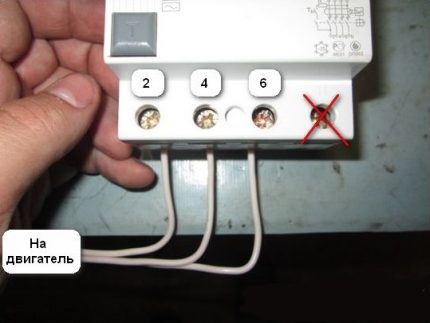
A single-phase circuit for standard needs, such as lighting and power supply, can be constructed quite simply by using a two-pole device and several circuit breakers.
Single-phase channels are routed to each individual room through circuit breakers, which are powered by the phase coming from the protection device.
This, one might say, is a classic circuit solution, which is used in most cases by owners of municipal housing, owners of houses and cottages.

Modern housing projects involve organizing circuits with the mandatory presence of a grounding bus. Therefore, such solutions are characterized by minor changes/additions to the wiring diagram.
In particular, the grounding conductor (PE), which is the same integral part as the zero bus, becomes an additional element of the wiring.
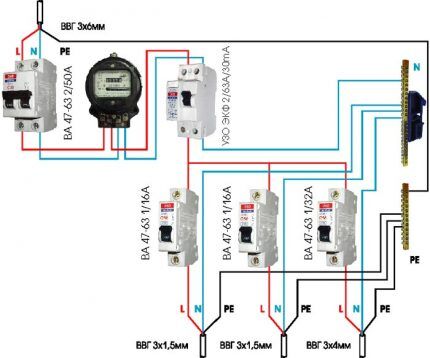
In apartments, houses, and cottages, selective protection devices are a mandatory addition to the apartment electrical panel when residents use household appliances:
- washing machine;
- dishwasher;
- powerful electric stove (stove).
Moreover, this type of device (selective) acts, as a rule, as the second protective stage, while at the first stage there are RCD cutoffs for direct direct contact.
That is, there is a group connection of devices and this is a really effective option in terms of the safety of operation of household electrical networks.
Nuances of connecting type S modules
Actually, the nuances are the same as those that accompany the process of connecting standard protective devices.
The terminals of each device have a specific purpose (phase, neutral) and are designated accordingly.

During installation, it is unacceptable to change the positions of the terminals regarding their purpose in relation to the power circuits.
If you connect a zero bus instead of a phase, there is at least a risk of failure of the device itself. It is extremely difficult to confuse two points, but in practice this happens.
Another nuance is the adjustment of the module to the existing electrical circuit in terms of current cutoff.
If the design does not include current adjustment options, you should select the correct device according to its technical and operational characteristics.
Finally, a mandatory connection nuance is device testing in the mode of supplying power to the load circuit.
This function is simple and requires only one action - activation of a special button, which is designated on the case/in the documentation as “Test”.
Conclusions and useful video on the topic
An accessible and understandable video explanation of the selectivity of the protective device:
The video demonstrates the practice of switching on a group of devices and the actual operation of devices in emergency situations:
You can often find arguments regarding the ease of connecting an RCD to the electrical network of a private home. Along with reasoning, it is often recommended to do this work with your own hands. The motive is well known – saving. However, skimping on your own safety is not the best choice. Therefore, such actions for installing a selective protection device should always be performed by a professional electrician.
Do you have experience using or connecting selective RCDs and can you supplement our material with interesting information on the topic of the article? Please write your comments and ask questions in the block below.




As I understand from the text, the RCD is additional protection. It is not very clear what advantages the use of this device brings other than increasing the complexity and cost of the electrical circuit. At the moment, circuit breakers and grounding are available as protection. If they are in good working order, then the rest is from the evil one. I think that the purchase and installation of RCDs will be made obligatory for everyone.
Andrey Vorontsov, I didn’t really understand the sentiment of your comment.Are you either contradicting yourself, or are you trying to say that RCDs will be imposed on everyone in order to make electrical circuits more expensive? Well, you should read more about the device itself before writing comments. What's the point if you barely understand what it's all about? This is not a big increase in price for networks, but protection reaches a new level.
Did you read the article carefully? In what part of the text does it say that the installation of an RCD is mandatory or is it planned to be made so? How can this be a reality if every second apartment does not even have mandatory grounding on the corresponding household appliances.
The article describes what a selective RCD is and the nuances of its connection, presenting it as an alternative (key word) to the current means of protection that are currently in use. At my home, selective protection is implemented on the most expensive equipment: washing machine, refrigerator, dishwasher and TV. The PC is connected via a UPS, so this is not relevant for it.
I will give an example of the usefulness and necessity of RCDs (diffautomatic devices). Automatic switches protect a section of a circuit from short-circuit currents and from overload. Grounding transfers dangerous potential from the body of an electrical device to the ground. However, a person (or any animal) is a sensitive organism, not to mention the fact that the safety of people and animals is incomparably more important and valuable than any “hardware”. Now an example of why automatic circuit breakers and grounding will not replace RCDs. There is an electric kettle in your kitchen. You put a hot frying pan on and accidentally leaned it against the kettle wire. The temperature melted the wire insulation and the phase voltage of 220 V appeared on the body of the frying pan.Then someone came up and accidentally grabbed the refrigerator door and the frying pan with wet hands at the same time, but... If there is a transition resistance, then, for example, a current of 50 mA will flow through the human body. No machine will “feel” it, but this current will not let go. Non-releasing is a current of more than 10-15 mA. A person receives an electrical injury. And a current of more than 100 mA can generally lead to cardiac arrest. The RCD will instantly turn off this section of the circuit.